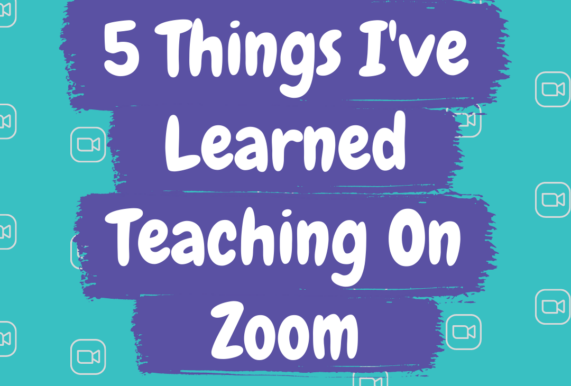
From Zoom classes to Facebook live streams and InsideOut At Home lessons, InsideOut’s programs have looked a little different this year for both students and teaching artists. But despite all of the new challenges of virtual teaching, our Writers-in-Residence have made the most of this year by taking creative approaches to technology, emphasizing social-emotional learning, and finding other innovative ways to ensure we continue to empower youth voices no matter what form it takes.
Drawing from their own experiences leading online classrooms, Lead Teaching Artist Jassmine Parks and Senior Writer Peter Markus reflect and share their insights on building an imaginative, inspiring, and supportive virtual classroom.
5 Things I’ve Learned Teaching On Zoom
Jassmine Parks, Lead Teaching Artist
1. Redefining successful engagement
Students have core classes that are packing their minds with essential need-to-knows for testing and college preparation, so when they have a chance to break the monotonous routine, offer them new things. I’ve found the virtual platform Padlet to be useful as students can upload videos, images, art, and comment on each other’s posts just as they would engage with social media. I’ve also used Mentimeter, where you can use polls to play “this or that” or create word art in colorful hues of all student responses to a discussion question and so on. Find resources that are fun and visually interesting to pull students in.
2. Reading the room
Most virtual classrooms are black screens in which teachers are unable to gauge the faces for understanding and interaction. That doesn’t have to be an obstacle because students have a viable option to use chat to communicate their thoughts, feelings and questions. Some students are apprehensive speaking on the mic, but have the courage to share ideas via chat, white board or other ways. As the teacher, you can play with how you read these chat comments aloud– change your voice (tone, inflection, pitch), sing it aloud, do a theatrical dramatic reading, etc. It encourages students to continue to share what they’re thinking in a low stakes way, as well as providing the opportunity to private message a teacher directly should they need help immediately or want to participate, but not weigh in with all of the students watching.
3. Interactive lessons get the crowd going
I find that students enjoy things that involve moving their bodies and tapping into a sensory experience. Youth have enjoyed engaging in scavenger hunts where they find sentimental items that awaken memories for narrative building. Students have experimented with the scent, touch, and taste, of their favorite snacks to discuss imagery. Youth have also played rock, paper scissors, truth in which they only turn the camera on their hands and the loser of the battle answers a question that reveals a little bit about themselves.
4. Curate a playlist
Any opportunity to center youth voice and expertise is vital. One of the best ways I’ve been able to do this is have students request songs to play during moments of down time and writing prompts. You learn so much about each student through their music choice and it helps set a culture while also building community. Students, as well as myself, love to update our personal playlists with new additions and have banter about the various selections.
5. Adapt, adapt, adapt
As shiny as our lesson planning may be, students may need a break from being taught due to screen fatigue. This is a perfect opportunity to listen and be taught by students. Get their feedback on their interests, such as meme creation, making Tik Tok videos, playing the trivia game Kahoot!, and so forth. Trust that youth are aware of what they need and making space for a couple sessions to be flexible allows them more autonomy, community control and buy-in that you care about their voices by reaffirming their sense of agency.

10 Ways of Looking At or Through Zoom
Peter Markus, Senior Writer
1) When the bird flies into the window, see this as a sign that it’s better to be inside right now.
2) It’s okay to repeat yourself, to say the same bird twice, since chances are the first time didn’t happen, or wasn’t heard.
3) Don’t be afraid to ask seemingly simple questions with seemingly simple answers because nothing is ever as simple as it seems to be. The question “Why can you see and hear me?” for instance.
4) Words can sometimes be both a verb and a noun. Zoom, for instance. Somebody took this verb and made it a noun. Kind of like the word “trip” which is both an action and someplace we go or are taken.
5) Just go with it. Call it the flow. Things are happening around us all the time, the good with the bad. Be optimistic. Trust the process. There is often truth in cliches.
6) Sometimes a silly hat helps. But sometimes a silly hat is simply a silly hat.
7) It’s kind of like staring into the mirror all day and talking to yourself.
8) Drink lots of orange juice. In a Mason jar no less. When you don’t know what else to say, reach for the Mason jar. Raise the juice. “Like orange juice” which is what you might compare joy to, or gratitude, or even the sun.
9) When the sky outside the window is blue, ignore it. You can’t go there right now.
10) After a while it’s hard to ignore what’s right in front of you. Go outside. Roll around in the blue of the sky. That’s what birds do. That and sing. So open your mouth, open your eyes, and tell about it. That’s what writers do.